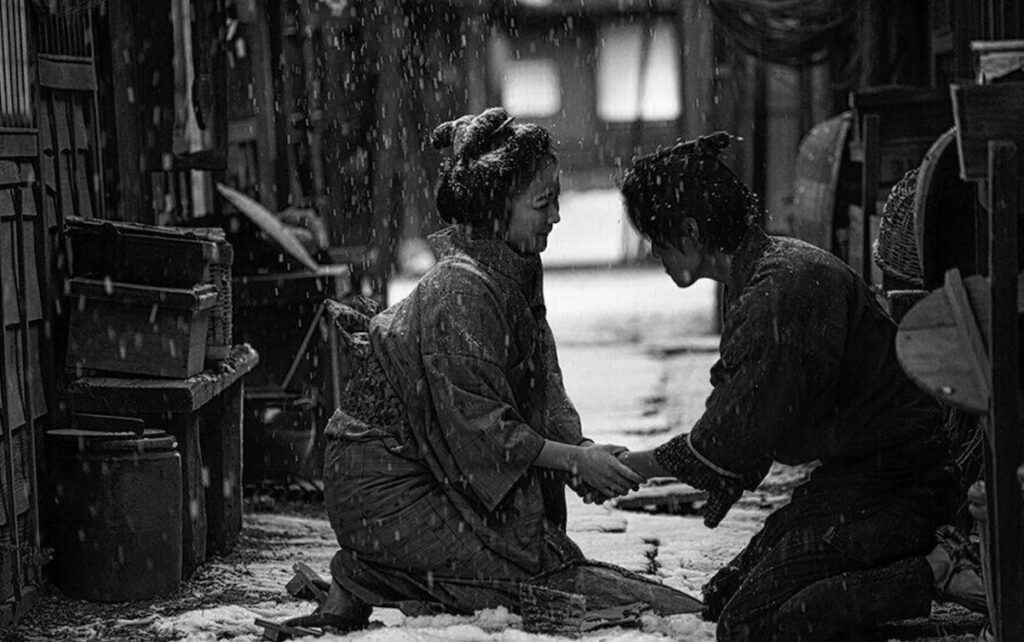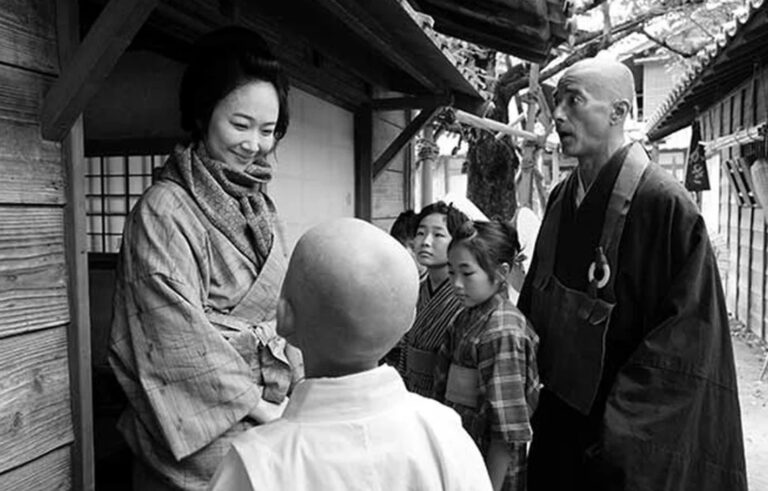
Synopsis : Edo-era Japan is remembered for many things — brutal nation building, isolationist foreign policies, the last samurai. Leave it to veteran auteur Junji Sakamoto to remind us that it also marked the culmination of a truly sustainable ecosystem. In his audacious, aesthetically brilliant new jidaigeki, Okiku and the World, the director achieves a perfect blend of potty humor, cutting social commentary and budding romance set amidst the fecal ubiquity of the mid-19th century. As playful as it is soulful, the film focuses on two unlikely protagonists, “manure men” Yasuke and Chunji, who collect human waste from tenement outhouses and resell it to farmers in the countryside. Chunji longs to woo lovely schoolteacher Okiku, who longs to see the world but cannot, because she must support her father, a fallen samurai. To see Sosuke Ikematsu energetically scooping out latrines; to hear Koichi Sato delivering a treatise on love to his real-life son, Kanichiro, as he battles constipation; to view the ever-demure Haru Kuroki complaining about farting — these are delights you never knew you needed, but will never forget.
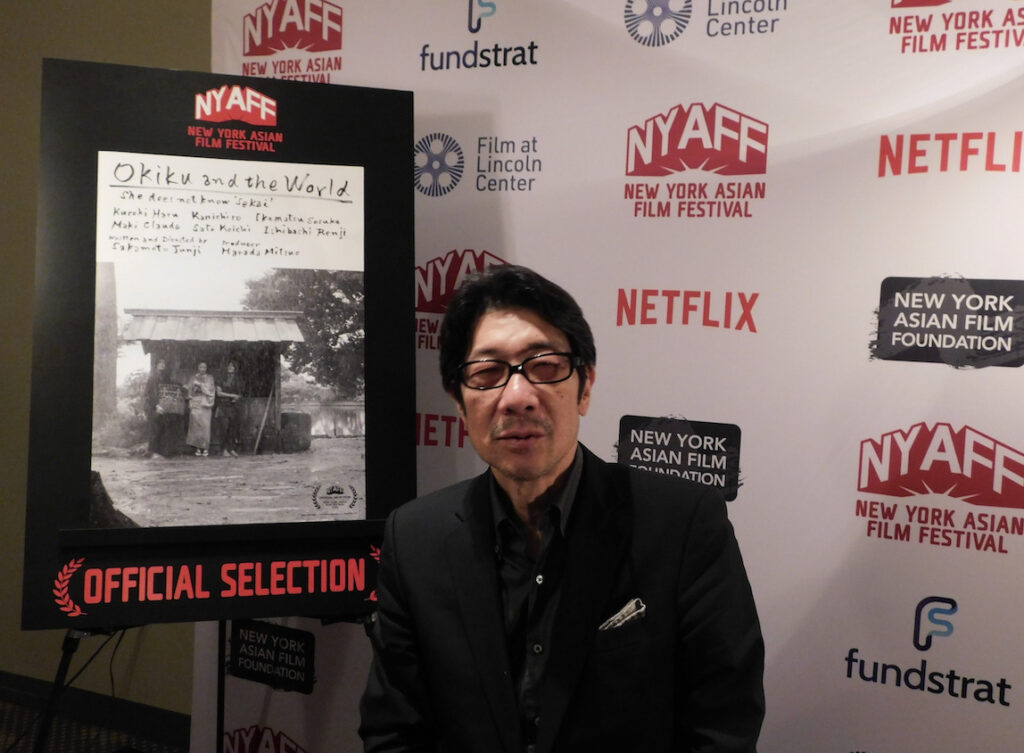
Q: Mr. Harada, an art director who had worked with you for many years, originally brought this project to you. You two initially made a pilot, so what was the process of working on the pilot and then turning it into a full-length film?
Sakamoto: If you include my time as an assistant, I’ve known Harada almost 30 years now. To put a finer point on it, he got very sick four years ago, at the beginning of the Covid pandemic. He lost his job. He had a lot of time to think then. So he came to me for advice, saying that he wanted to produce and make something socially conscious, not just for art. He said to me at that time that he was not the type of person who would talk about a circular bio-economy [economic growth in harmony with nature] or the environment. but when he mentioned these things to me, I thought it would be a good idea to use such beautiful words as a message.
I told him that if it were a contemporary environmental issue, I myself wouldn’t be so confident. However, I thought that Japan, which had no resources in the Edo period [1603-1867], had a cyclical economy in which manure was used as fertilizer, vegetables were produced, and then put into people’s mouths — ahead of the West. I was interested in the idea of a world that understood manure. In short, I told him that I wanted to make five or six period dramas with the circular economy of manure as the backdrop, so I would do it.
Harada told me three years ago that he couldn’t raise funds immediately, but that he wanted to make a short film with his own pocket money, which became the pilot version. He took it and went around to film companies to raise money to make a feature film, but it didn’t work out that way because of the pandemic. It didn’t make it as a pilot version. Harada got jitters and said he wanted to make another short film which was two years ago, so we shot another 15-minute film. We made those two into a pilot version, but still couldn’t raise the money.
Q: Was it difficult to raise the money because of the pandemic?
Sakamoto: We were in a dire situation with Covid, the fecal matter, the monochrome, and so on, and a certain foundation that had nothing to do with the film company at all and had nothing to do with film came on board to fund this film, and they gave us the money last year. So we shot the other 60 minutes and combined them into a 90 minute film.
Q: That’s great. What was interesting about this film is that there have been many Edo period films, but not so many that depict people dealing with filth or the lower class. But those people also fell in love. That part of the film was very new. Were you interested in those aspects as well?
Sakamoto: If I were to make a period drama, I was so interested in samurai stories. Rather, I wanted to make the main characters from the lower classes — people living on the ground. I myself liked such period dramas when I saw the films by my senpai [senior directors]. I also wanted to depict the Edo period from a lower point of view — how they were treated, how they lived undaunted, and how they fell in love. I wanted to depict the Edo period from a lower perspective.
Q: Did you have any specific references? Neighborhoods in today’s society have security attached to them, and a society has formed where people don’t even know their neighbors at all, but in contrast to that, in this work, people are very neighborly, and they talk to each other as if they know everything about each other. That’s a very fascinating part of the story. Are there any references that you used to learn about such things?
Sakamoto: During the Edo period [1603-1867], Japan was closed off from the rest of the world. It was the Dutch in the West, and before that, the Portuguese, with whom there were negotiations, including trade. There are documents in which Westerners, such as Siebold [Philipp Franz Balthasar von Siebold], a German doctor who came to Japan via Holland, wrote down what they saw and heard while living in Japan. What they were all surprised about was that in the West, feces and urine were thrown into rivers or dumped on roadsides, but there are a number of references in literature where people in the West are surprised about this circular economy in Japan where you buy poo, spread on the fields, vegetables are produced, and then it goes into your mouth. That’s how I came to know about it.
There were also caricatures and cartoon-like illustrations of the common people of Edo, and there were also cartoon-like illustrations of the guy who handled filth, umbrella craftsmen, and other Edo period craftsmen who used up or repaired things to the last, rather than throwing them away. It was a good visual reference for me. Then there is rakugo [traditional Japanese comic storytelling]. Novels are all about samurai families, but there are really only a few about people who lived in tenements and how they used language.
There are only a few novels about ordinary people. I thought that would be a good idea, so I listened to rakugo. There are many funny stories about people living in tenements, so I learned the spoken language from them, and the community was in close contact with each other, including gossip, with the well in the middle. It was a time when people had to help each other to make a living. Tenements were often hit by floods, fires, and other disasters. At that time, the more people who had strong ties to each other were around, the more likely they were to help each other out in times of crisis.
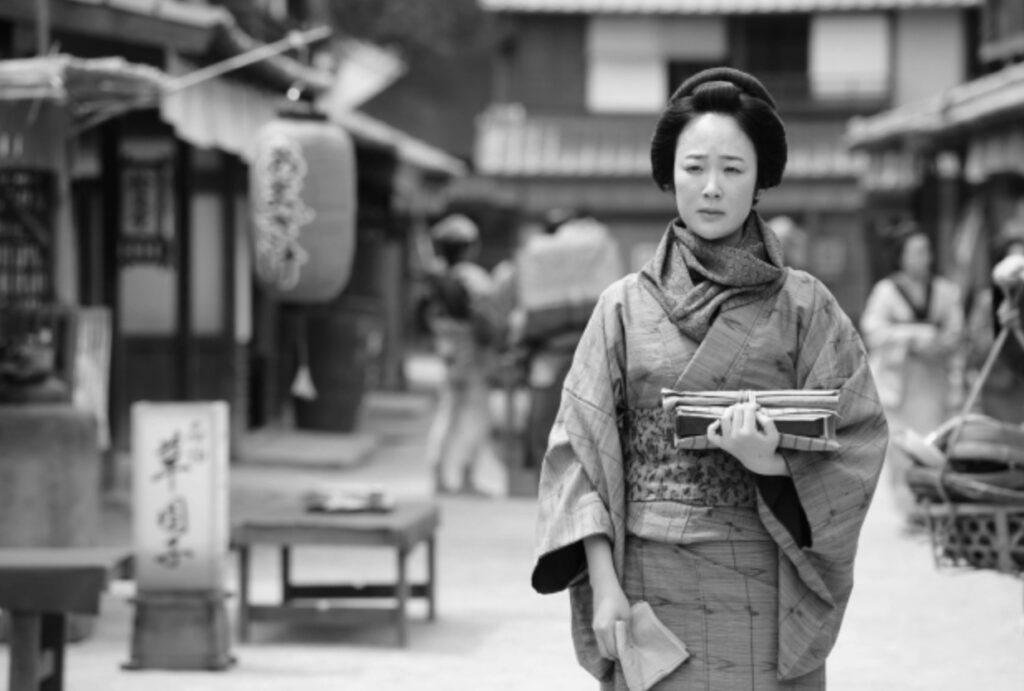
Q: Sousuke Ikematsu has been active as a child actor since the film, “The Last Samurai.” He seems to be very particular in his choice of films. What was it about his performance that led you to cast him in this film?
Sakamoto: First of all, the pilot version three years ago was shot with Kanichiro and Hana Kuroki, and two years ago with Kanichiro and Ikematsu. As I said, I didn’t know if this would work or not, but we started shooting a short film with the aim of making a feature. The budget was very low, and we weren’t sure if we would see the film completed or not, but the people who said they could do it, including the office, were Mr. Ikematsu, Hana Kuroki, and Kanichiro. I think Ikematsu has a sense of smell as to how to choose a good film, and I had high hopes for his work because he has this sense of smell so that it would be a very distinctive work among many Japanese films.
And, it would surely have some message while being entertaining for audiences. They understood the middle of the so-called message, and they played their roles, not only their own, but also with an eye to what kind of idea they could bring to the overall picture. Such people are always highly aware of the current society and the future. I think this is reflected in their performances but I don’t mean on the level of whether they are good or bad. Actors usually play someone who is not themselves — they’re always playing someone else. There’s an overlap between that edge of being myself and the edge of the role.
So actors think, “Oh, this role is similar to me in this way, but I can also play roles that don’t overlap at all.” But there are also times when actors play roles that don’t overlap at all. For example, actors train themselves to think about other people on a daily basis in preparation for the roles that might come their way, such as a serial killer, for example. I don’t know if it’s the right word to call it “training,” but that is how he [Ikematsu] looks at the world, and in that sense, no matter what role comes unexpectedly, he chews it over in his mind, interprets it in his own way, and the depth of his interpretation comes out in all of his performances.
Q: There are things Ikematsu has cultivated over the years. In a sense, isn’t he’s also looking at things from a producer or director’s point of view?
Sakamoto: I think he actually wanted to be a director. After the movie, “The Last Samurai,” I think he took a course in directing in the film department of Nihon University’s College of Arts.
Q: In those days, there was no sign language in the Edo period, so how did you talk with Hana Kuroki beforehand about how she would express her feelings in what way?
Sakamoto: Without sign language or a voice, I felt that it would be impossible to leave it all up to the actor Kuroki to decide how to express her feelings. For example, I had already told her that if she could talk, she would say these lines, which was written in the script. Before she was cut on her neck by the Samurai (which caused her not to speak), she was a very active person who wasn’t afraid to speak her mind and say what was on her mind even to her superiors. The part where she explains that the onigiri got crushed is also written as a dialogue in the script of the film.
But I left it up to her to decide how the black flower would do that. If she could speak, she would say these things. In the first place, she’s a lively person. If she’s not ladylike, she’s going to say things, etc. We had these meetings. The part at the end where they brought rice balls in the snow, but they got hit by a cart and the rice balls got crushed, she explains that the rice balls got crushed. That’s in the script of the film as well. But I left it up to Kuroki Hana to decide how she would do it. If she could speak, she would say these things. In the first place, her character Okiku is a lively person. If she’s not ladylike, she’s going to say things, etc. So we had these meetings.
Q: She used to be a Butoh dancer, so her movements, such as her posture, were somewhat reserved as a member of a samurai family. She blended in quite well.
Sakamoto: She has experience in period dramas, but is very conscious of how to dress in kimono and in geta [a traditional Japanese footwear resembling flip-flops]. Even the way she bows is limited only by the fact that she is wearing a kimono.
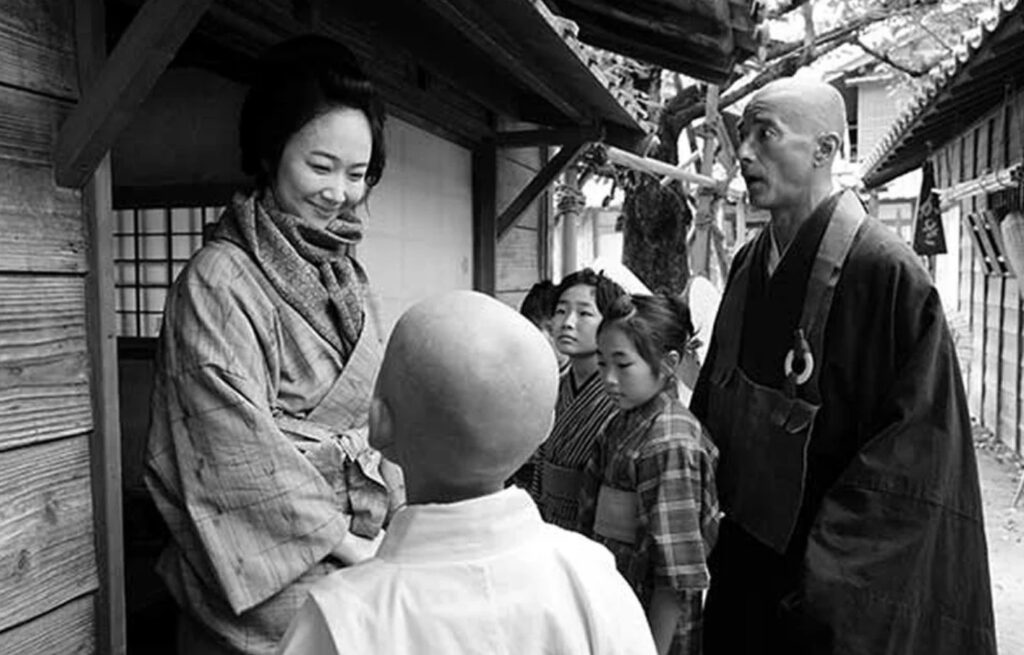
Q: Was it difficult for you to shoot the scenes with Kuroki, especially the scene with actor Claude Maki?
Sakamoto: In the snow scene with Kanichiro, there are props such as the bamboo skin that was actually used to wrap onigiri [rice balls] and the props that she uses to explain because she can’t speak. It was difficult to choose which one to use.
Q: This film is set against the backdrop of today’s SDGs and recycling- oriented society, but your films have more of a humanistic appeal to society than a major social theme, which is common in your past works, ever since the film “Dotsuitarunen.” That appeals to people — having a human touch which is more consistent than daring to raise a social theme.
Sakamoto: Perhaps it’s my nature, my physiology. As a result, it’s a good story if the message set forth at the beginning of the project is conveyed. And, to convey it fully, it still has to be a human story. Although it is a play on words, I always say that it’s not a story, but a human story. It doesn’t matter whether the story is interesting or not, I have chosen to tell it to the people, and as a result, after watching the film, it is good if the audience realizes that there was something behind the story. Even if I start with a big message from the beginning, I usually try to be careful not to be too enlightening. I also try to keep a low point of view.
Q: There is a phrase in the film, “The role is to divide the role, and what can’t be done is done by those who can.” There’s a form of our society in which those who can do it do it, but there’s also the viewpoint of whether we should leave it to them. You explained it very clearly. What was the intention to use these lines?
Sakamoto: That’s exactly what the film industry is all about. In the process of filmmaking, everyone has a role and responsibility, but sometimes, if you can accomplish your role to a certain extent, you can go to help others. Or, if there is a staff member who is full up, you can go out to help him or her. I think that’s where this line came from.
Q: The majority of the film was shot in black and white this time. Shooting in black and white is time-consuming and expensive so what was the significance of trying black and white this time, and what did you feel after actually doing it?
Sakamoto: Well, the black-and-white world is not real. It’s visually impossible in real life. However, I like that kind of fictionality, and it is interesting to see how I can make it grounded. Because it is unreal. On the other hand, it creates another task to pull it into our own familiar reality, so I have wanted to do black-and-white for a long time. But nowadays, it’s very difficult to get a project approved to make a black-and-white film in Japanese cinema. Since Harada and I started this project as an independent production, no one resisted us, and we said, “Let’s do it.”
The difficulty with black-and-white is that unlike the black-and-white Japanese films of the past, this one was shot with a digital camera, and what was shot in color had to be converted back to black-and-white. If you put them side by side with the black-and-white films of the past, there’s no flavor to them, including a somewhat rough feel. It’s not enough to just shoot the scene. For the rain scene in the tenement house, we used a set in Toei Movie Land [where many Japanese period pieces were shot] that had been used in other films and TV dramas, and decorated it according to our period setting and the sense of the season. Then, we added more contrast. If you shoot a film in a normal way, it would be monotone, but we wanted to make it more vivid.
Since there’s no color information, we would have two people carry a wind blower machine on their backs and splash water on the film before shooting, and this would create shades of gray. Akira Kurosawa, when he used black and white, would paint only the pillars on this side with charcoal to create contrast. Kurosawa also did it with sumi ink in the rain. Monochrome is monochrome, and it’s crafted differently from color. I was concerned about areas that I didn’t care about at all in color, and among various solutions, I would pour water on it to create shading. But we do it when it’s hot, so when we say “Cut one more time,” it’s dry. We did things that we don’t usually do, such as creating shading by spraying water.
Q: Now that your film has been selected for the New York Asian Film Festival, what kind of films do you want to make in the future?
Sakamoto: This time, we shot the film in 12 days. Everyone was on a tight schedule, and everyone was on board with Harada’s project, whether it be compensation or money. We were all “accomplices,” and that’s why we were able to shoot in 12 days. We were able to unite our thoughts. However, I think it’s different to continue making films because it’s not possible to continue making a film like this, because everyone has to put up with it. At this point, I’m not sure which of my projects will catch on, as I will do what I want to do with the work that comes my way. I’m also planning to submit my own original works to various places.
However, there are certain things that will never change in me, and I would rather work on films where I can’t use my old techniques than on films where I can. I would like to do films where I have to do my homework on new things I have to learn. However, I’m already 65 years old, so there are a lot of young directors taking on more and more work, and it’s meaningless… And unless I know how and how much I can raise my hand and get them to call on me, I need to do something different to appeal to them. When I was younger, I was competitive and tried to move forward, but now I have decided not to move backwards. I think I can maintain myself better that way today.
